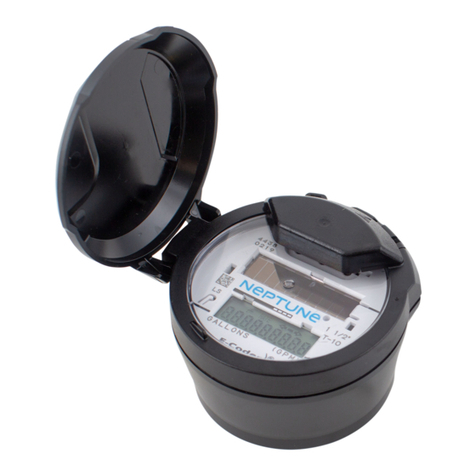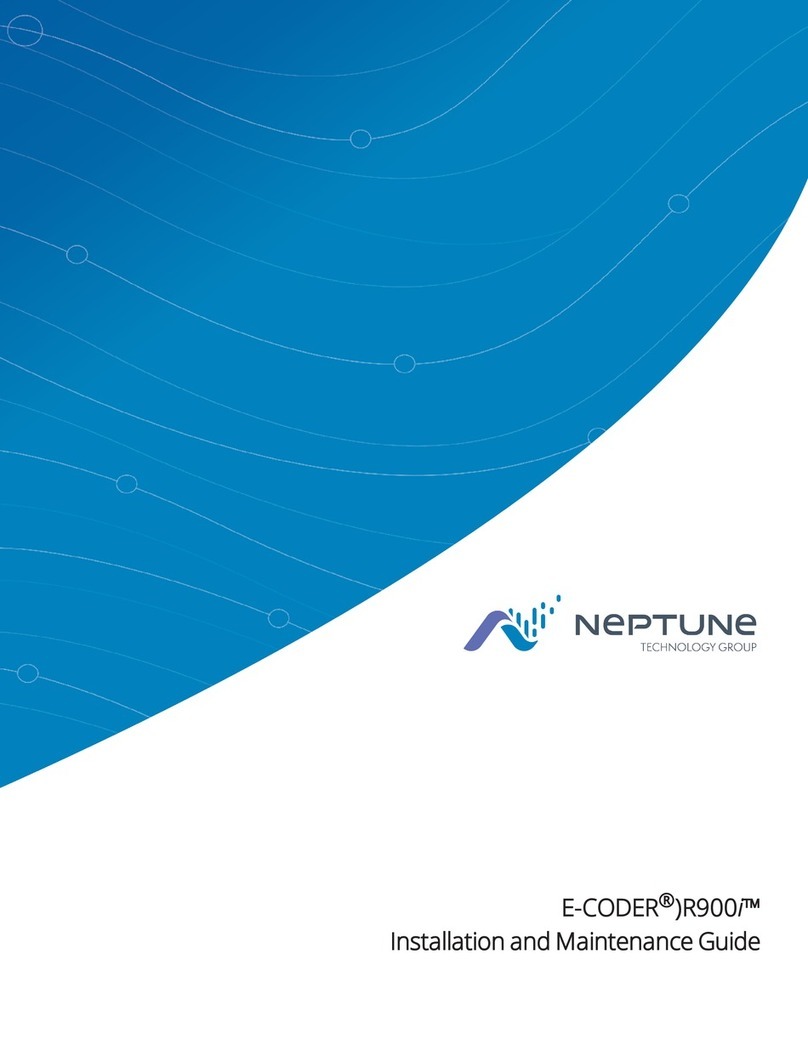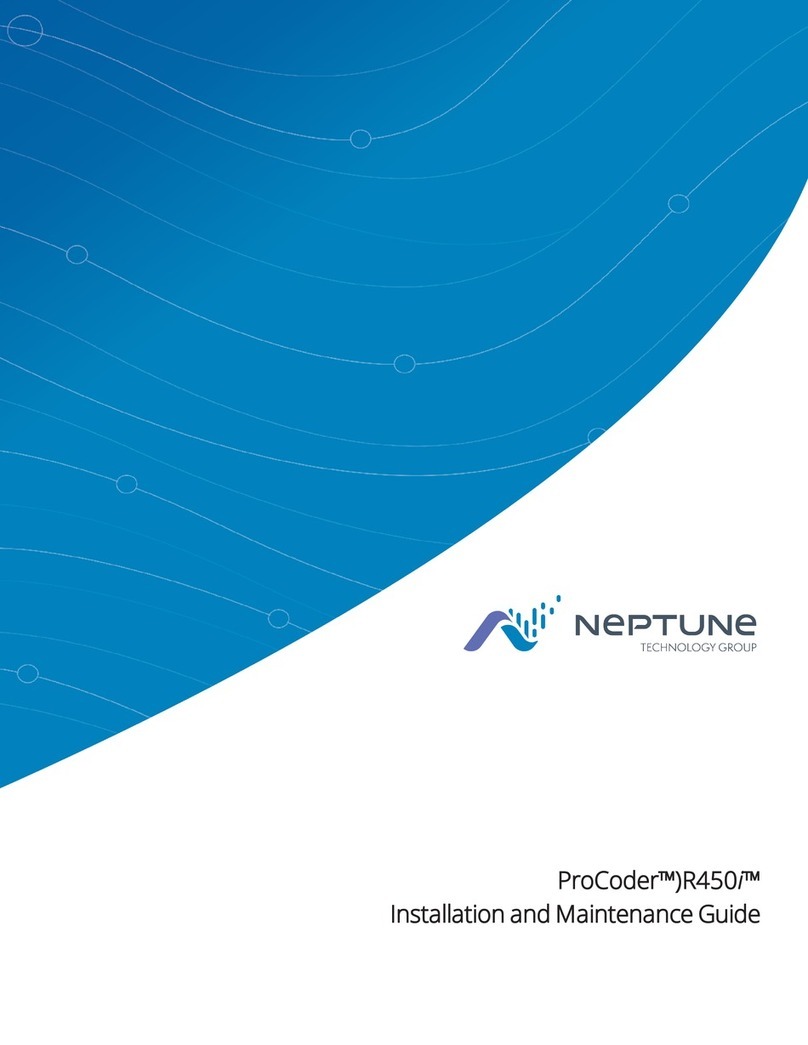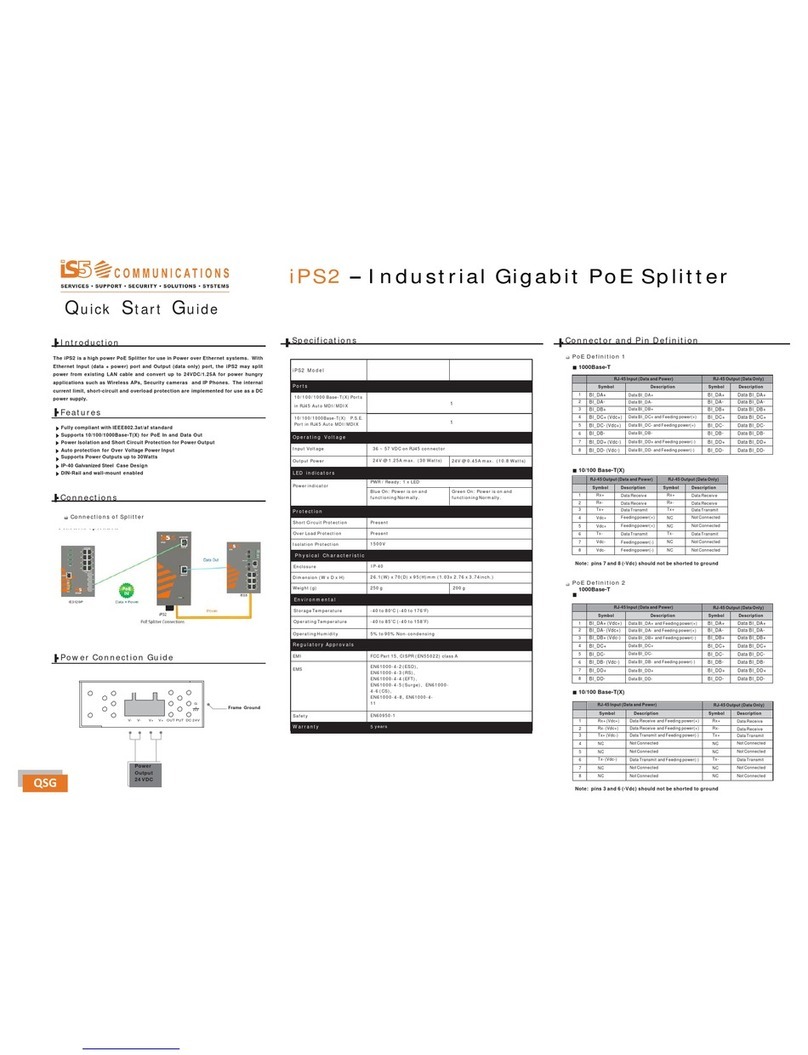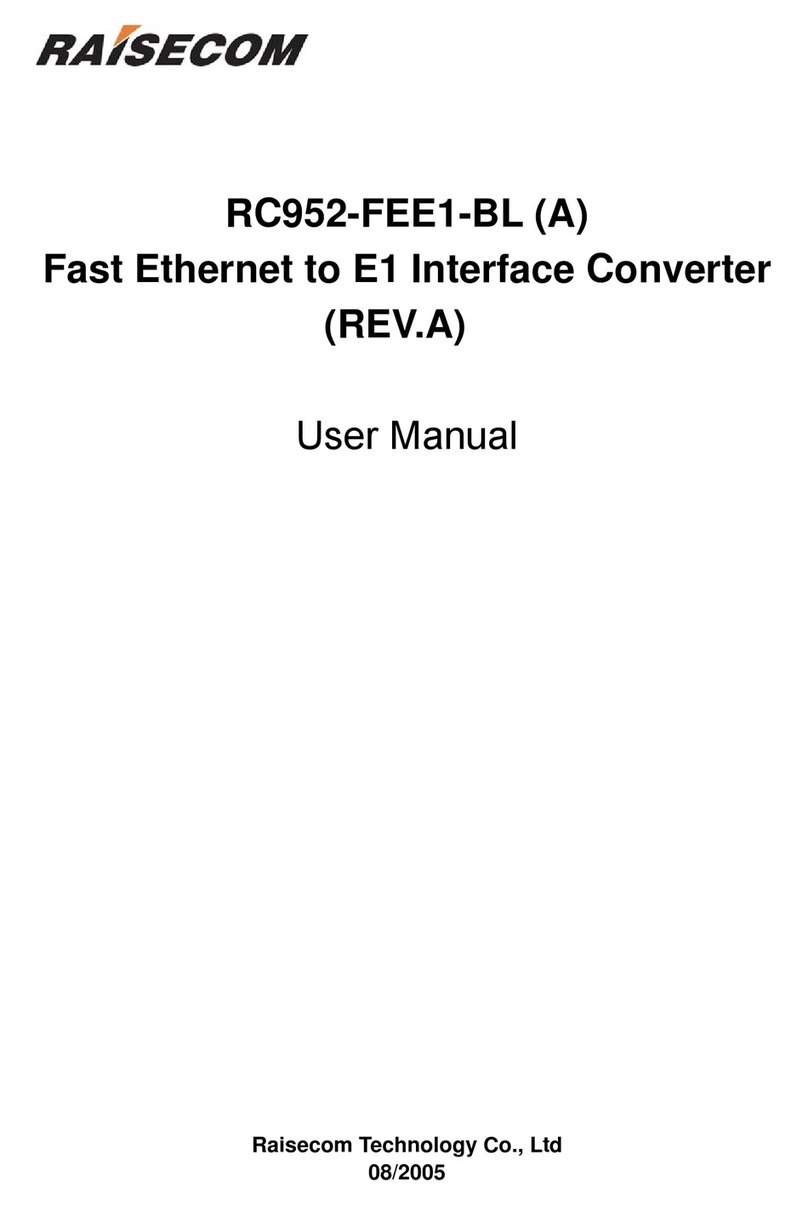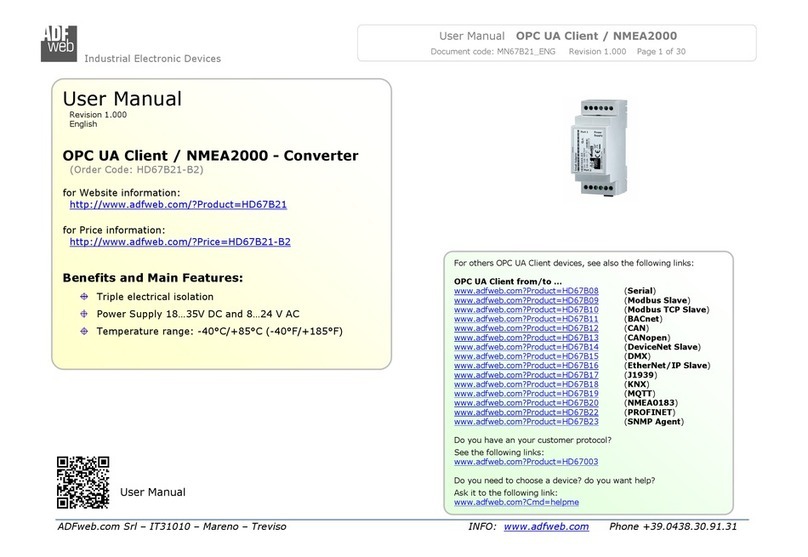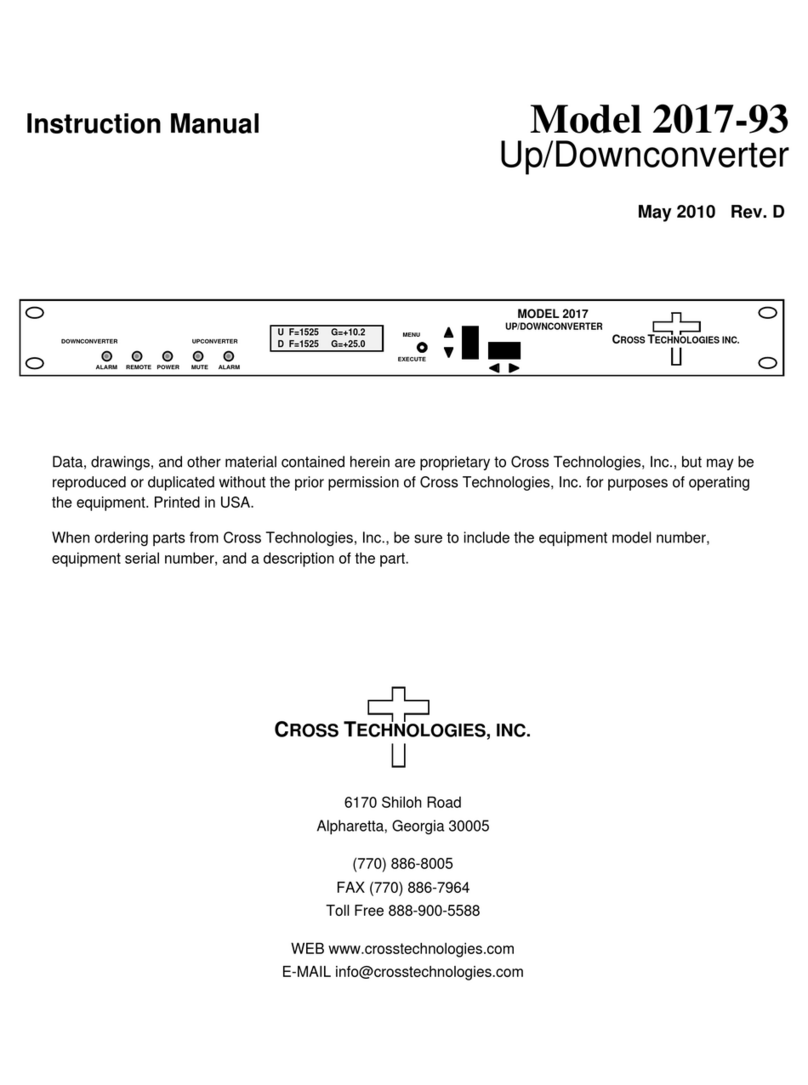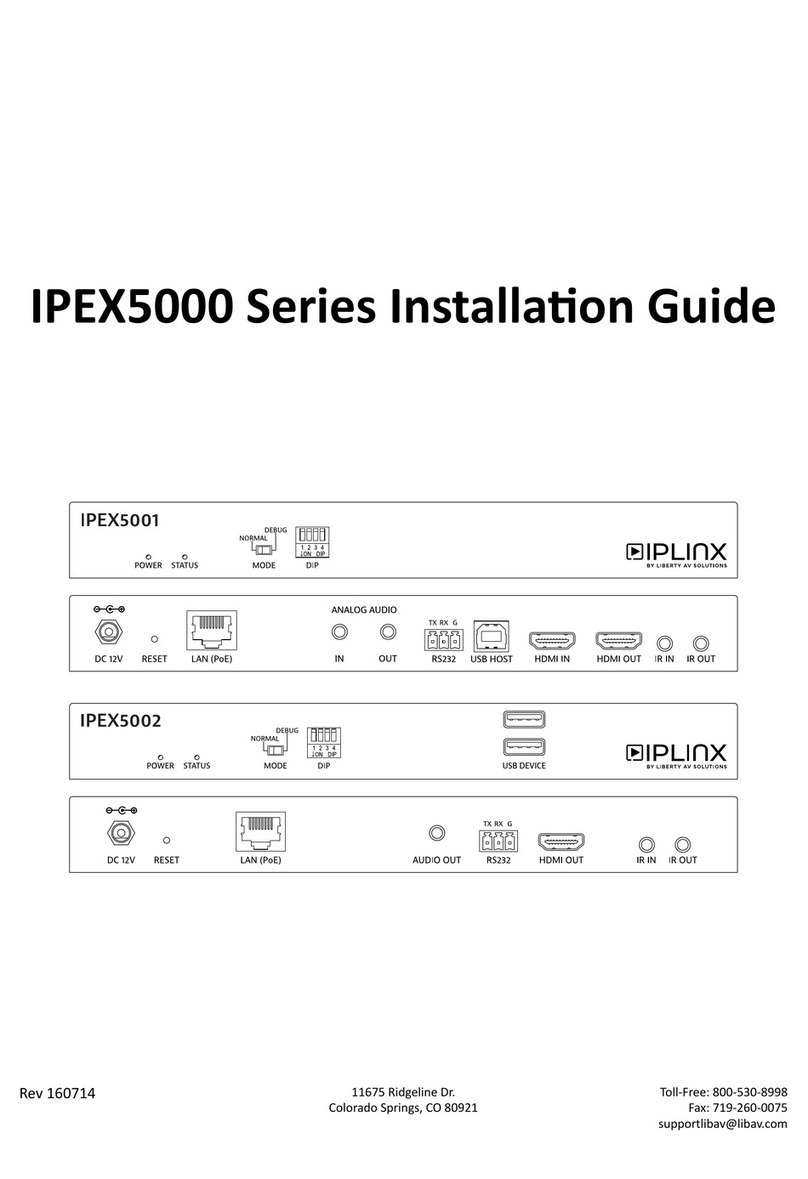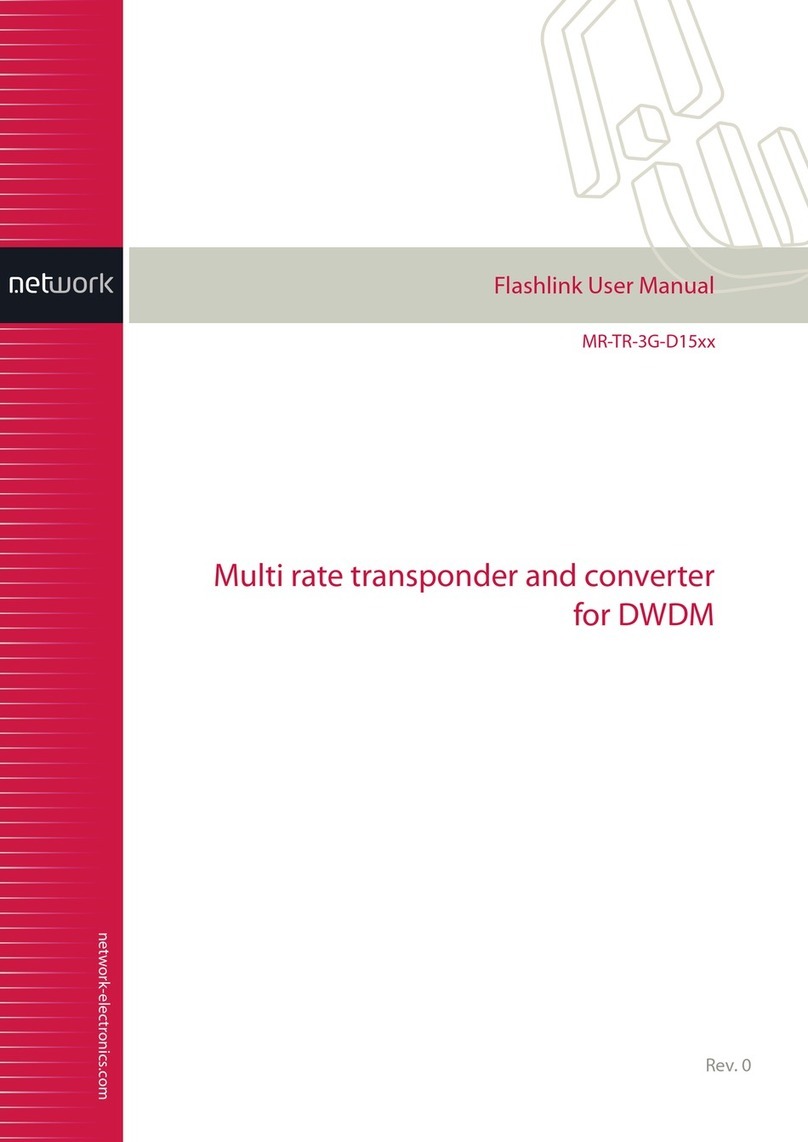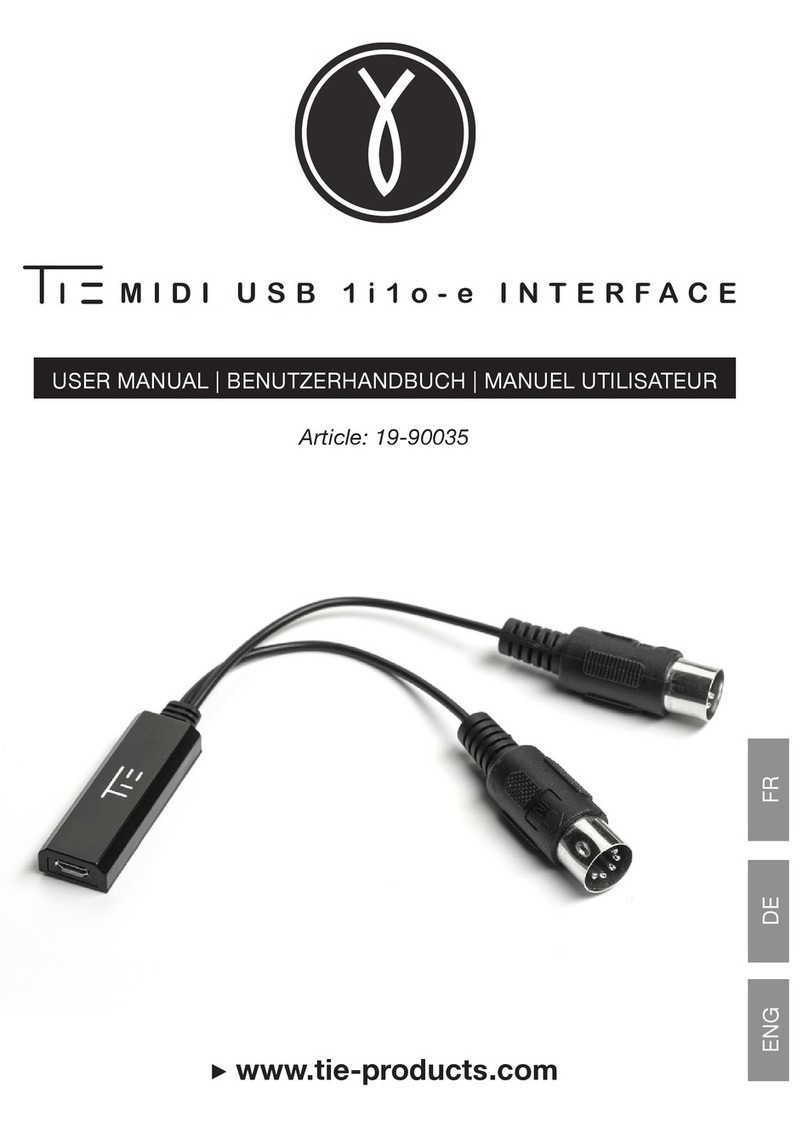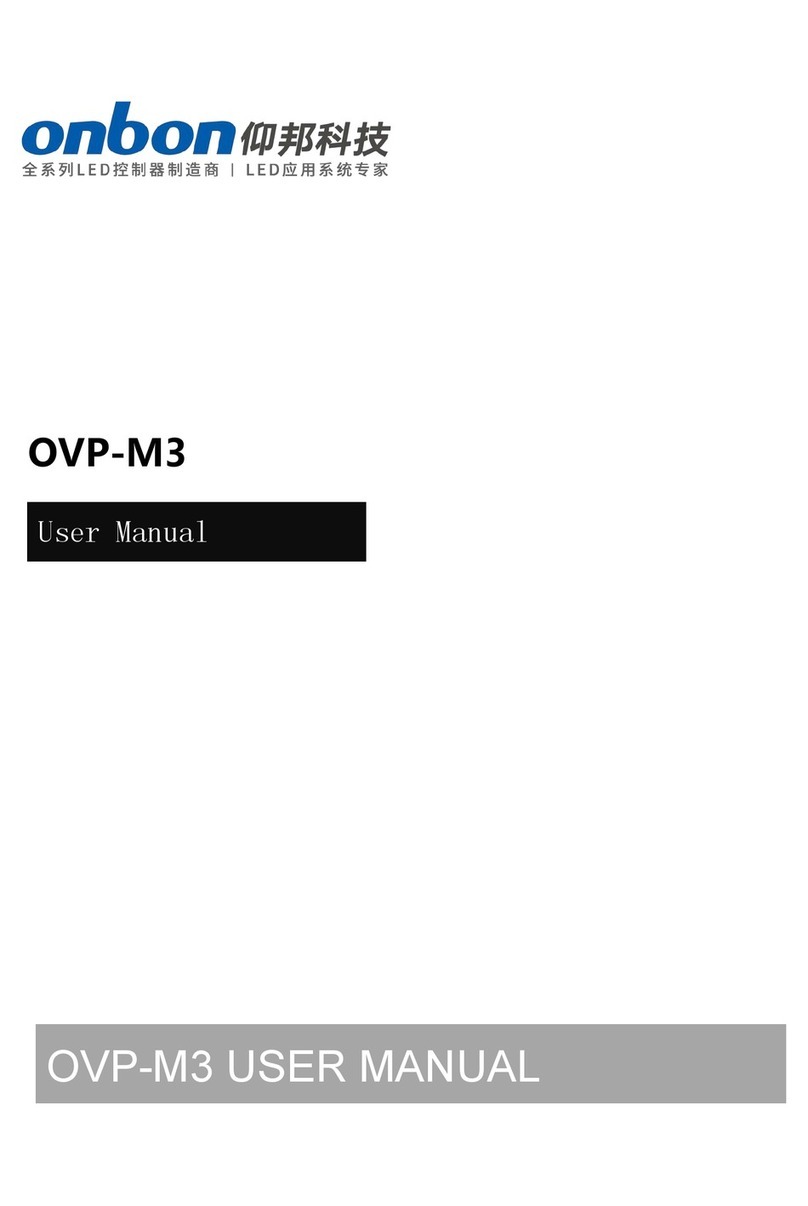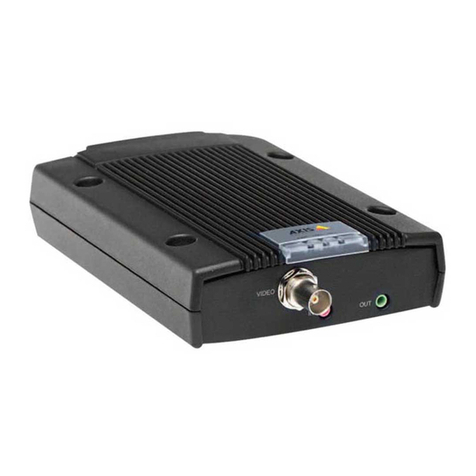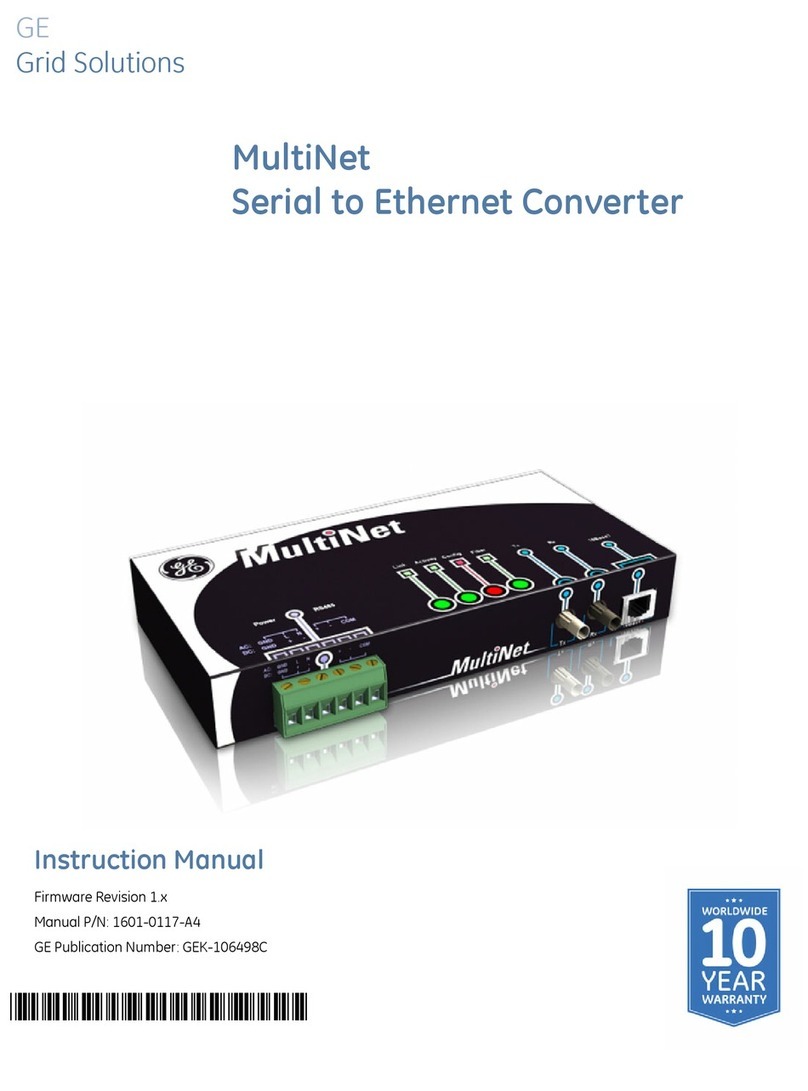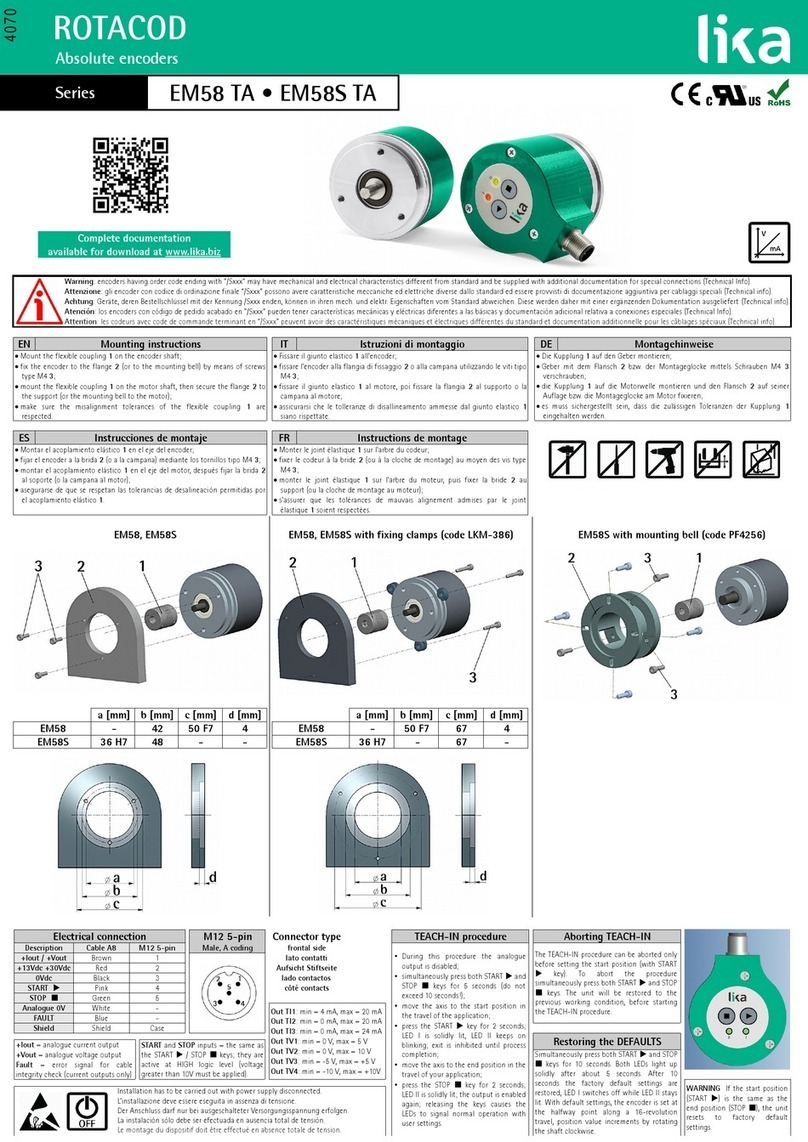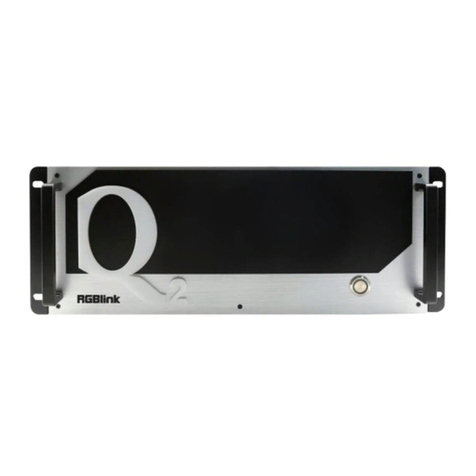Neptune ProCoder User manual

ProCoder™
Quick Install Guide


1: Product Description
The ProCoder™ is an electronic absolute encoder
register designed for use with the Neptune®
Automatic Reading and Billing (ARB®) System. This
register operates with the Neptune R900®and R450™
Meter Interface Units (MIUs), providing advanced
features such as leak, tamper, and backflow detection.
With the ProCoder register, both the homeowner and
the utility can use the following features:
lMechanical wheel bank for an absolute visual
reading
lEight digits for billing
lSweep hand for extreme low flow detection and
directional water flow indication
Figure 1: ProCoder™ Dial Face with Sweep Hand
This guide helps you identify and read information
displayed on the ProCoder register. It also helps you
recognize the common causes of leaks and instructs
what to do if you find one. This guide contains steps to
determine whether a leak is fixed after repairs.
- 1 -

2: Wiring Inside Set Version
To run a three-conductor cable from the ProCoder™
register to the MIU, complete the following steps.
1. Connect the three-conductor wire to the encoder
register’s terminals as described in the
manufacturer’s instructions, using this color code:
lBlack / B
lGreen / G
lRed / R
2. Remove the terminal cover with a flat-head screw
driver.
Figure 2: Removing the Terminal Cover
Figure 3: Wiring with
Proper Color Wire
3. Wire the encoder
register with the
proper colors.
4. Test the wiring to
verify the read.
- 2 -

5. Route the wire as
shown.
Figure 4: Routing the
Wire
Figure 5: Applying
Compound
6. Apply Novagard
G661 or Down
Corning #4 to the
terminal screws and
exposed bare wires.
Neptune recommends Novagard G661
or Dow Corning Compound #4.
Novagard may cause irritation to eyes
and skin. If swallowed, do not induce
vomiting; dilute with one to two glasses
of water or milk and seek medical
attention. Please refer to:
lMSDS Novagard Silicone Compounds
& Grease Inc. 5109 Hamilton Ave.
Cleveland, OH 44114
216-881-3890.
- 3 -

lFor copies of MSDS sheets, call
Neptune Customer Support at
(800) 647-4832.
3. Place the terminal cover
on register, ensuring the
wire is routed through
the strain relief.
Figure 6: Placing the
Cover on the Register
Figure 7: Snapping the
Cover in Place
4. Snap the terminal
cover in place by
pressing on the
molded arrow.
- 4 -

3: Wiring the Pit Set Version
To wire the pit set version, complete the steps. Figure 5
shows the components required for installation.
Figure 8: Installation Components
Figure 9: Scotchlok
Connector
1. Hold the Scotchlok™
between the index
finger and thumb
with the red cap
facing down.
2. Take one non-stripped
black wire from the
pigtail and one from
the receptacle / MIU
and insert the wires
into the Scotchlok
connector until fully
seated.
Figure 10: Seating the
Connector Wires
- 5 -

Do not strip the colored insulation from
the wires or strip and twist the bare
wires prior to inserting in the connector.
Insert the insulated colored wires
directly into the Scotchlok connector.
Figure 11: Crimping Tool
3. Place the connector
red cap side down
between the jaws of
the crimping tool.
Refer to Table 2 on
page 12 for part
numbers.
4. Check to ensure that
the wires are still fully
seated in the connector
before crimping the
connector. Figure 12
illustrates improper
connections due to
wires not being fully
seated.
Figure 12: Improper
Connections
5. Squeeze the connector firmly with the proper
crimping tool until you hear a pop and gel oozes
out the end of the connector.
6. Repeat steps 1 through 5 for each color wire. See
Table 1 on page 7 for the wiring configuration to
connect MIUs to the ProCoder.
- 6 -

MIU Wire Color/
Encoder Terminal
MIU Type
Black / B Green / G Red / R lR900
lR450
Black / G Green / R Red / B Sensus
Black / B White / G Red / R Itron
Black / G White / R Red / B Aclara
Black / G Green / B Red / R Elster
Black / G Green / R Red / B Badger
Table 1: Color Codes for Wires
7. After you connect all
three color wires, read
the encoder register to
ensure proper
connections, and the
receptacle / MIU is
functioning properly.
Figure 13: Three Color
Wires Connected
Figure 14: Splice Tube
8. Take all three
connected Scotchloks
and push them into
the splice tube until
fully covered by the
silicone grease.
- 7 -

9. Separate the gray
wires, and place in the
slots on each side of
the splice tube.
Figure 15: Gray Wires
in Slot
Figure 16: Cover in Place
10. Snap the cover closed
to finish the
installation.
4: Installation Instructions for
Networked Receptacle / Dual Port
MIUs
Enhanced R900 v4 MIUs are not dual
port capable. These instructions only
apply to v3 MIUs.
The Dual Port R900 and R450 MIUs work with
Neptune ProRead™, E-CODER®, and ProCoder
registers. Each register must be programmed in RF
Network mode prior to installation.
- 8 -

lE-CODER and ProCoder registers
cannot be programmed while
connected together in a network.
Each register must be programmed
separately prior to making the
network connection.
lThe designations HI and LO are
Neptune designations for the high
(HI) flow or turbine side of the
compound, and the low (LO) flow or
disc side of the compound.
lThe settings can also be used to
designate the primary (HI) and
secondary (LO) meters in a dual set
application.
Programming the HI Register
To complete the following steps, use the Neptune
Field Programmer to select the ProRead Program tab
for programming.
1. Select RF
Compound HI
format.
2. Match the
Connectivity 2W.
3. Match the Dial Code
65.
4. Type the
appropriate register
ID. Figure 17: HI Register
- 9 -

5. Program the register.
6. Read or query the register to confirm correct
programming. See Figure 17.
Programming the LO Register
Use the Neptune Field Programmer to select the
ProRead Program tab for programming.
Figure 18: LO Register
1. Select RF Compound
LO format.
2. Match the
Connectivity 2W.
3. Match the Dial Code
65.
4. Type the appropriate
register ID.
5. Program the register.
6. Read or query the
register to confirm
correct programming.
- 10 -

5: Wiring Networked Registers
Complete the following steps to wire networked
registers.
1. Connect each color wire with the appropriate color
wire from the pigtail and both registers, until all
three colors have been successfully connected. See
Figure 19.
Figure 19: Interconnection of Like Terminals
lRemove any bare or non-insulated
wire. Make sure that you only insert
insulated wires into the splice
connector.
lObserve proper polarity when wiring
the registers so that all terminals are
interconnected with wires of the
same color: red, black, or green.
2. Proceed to "How to Read" on page13.
- 11 -

6: Crimping Tool Manufacturers
To apply the Scotchlok™ connectors, Neptune requires
the use of a proper crimping tool. Table 2 shows a list
of various manufacturers and model numbers.
To reduce fatigue, use a tool within each
splicing group with the highest
mechanical advantage indicated within
the parentheses ( ).
Manufacturer Manufacturer’s Model
Number
3M E-9R (10:1) — To reduce
fatigue, use a tool within each
splicing group with the
highest mechanical advantage
indicated within the
parentheses ( ).
E-9BM (10:1)
E-9C/CW (7:1)
E-9E (4:1)
E-9Y (3:1)
Eclipse Tools 100-008
Table 2: Proper Crimping Tools
Use of normal pliers or channel locks is
highly discouraged because they do not
apply even pressure and can result in an
improper connection.
- 12 -

7: How to Read
It is important to become familiar with the information
available from the register.
Figure 20: Reading the ProCoder™
Figure 21: ProCoder™ Sweep Hand
The sensitive sweep hand provides a visual
representation of extreme low flows as well as reverse
flow. Depending on the size and type of ProCoder™
register, a specific multiplier is present. This multiplier,
along with the current position of the sweep hand,
provides additional digits of resolution that are
especially useful for testing.
- 13 -

For further information on reading the
ProCoder sweep hand, see the Product
Support Document entitled How to Read
the Neptune ProCoder Register.
8: Common Causes of Leaks
Leaks can result from various circumstances. To better
help you identify a possible leak, Table 3 contains
some common causes of leaks.
Possible Cause of
Leak
Intermittent
Leak
Continuous
Leak
Outside faucet,
garden or sprinkler
system leaking
Toilet valve not
sealed properly
Toilet running
Faucet in kitchen or
bathrooms leaking
Ice maker leaking
Soaker hose in use
Leak between the
water meter and the
house
Table 3: Possible Leaks
- 14 -

Possible Cause of
Leak
Intermittent
Leak
Continuous
Leak
Washing machine
leaking
Dishwasher leaking
Hot water heater
leaking
Watering yard for
more than eight
hours
Continuous pet
feeder
Water-cooled air
conditioner or heat
pump
Filling a swimming
pool
Any continuous use
of water for 24
hours
Table 3: Possible Leaks (continued)
- 15 -

9: How to Tell if Water is in Use
To determine if water is in use, complete the following
steps.
1. Look at the mechanical sweep hand.
2. Determine which of the following conditions exist.
If... Then...
The sweep hand is
moving slowly in a
clockwise direction
Water is running very
slowly
The sweep hand is
moving quickly
Water is running
The sweep hand is not
moving
Water is not running
The sweep hand is
moving counter-
clockwise
Backflow is occurring
Table 4: Determining if Water in Use
- 16 -

10: What to Do if There is a Leak
Refer to the following checklist if there is a leak.
Check all faucets for possible leaks.
Check all toilets and toilet valves.
Check the ice maker and water
dispenser.
Check the yard and surrounding
grounds for a wet spot or indication of
a pipe leaking.
Table 5: Checklist for Leaks
11: If a Continuous Leak is Repaired
If a continuous leak is found and repaired, complete
the following steps.
1. Use no water for at least 15 minutes.
2. Check the sweep hand.
If the sweep hand is not moving, then a continuous
leak is no longer occurring.
- 17 -

12: If an Intermittent Leak is Repaired
If an intermittent leak is found and repaired, complete
the following steps.
1. Check the sweep hand after at least 24 hours.
If the leak has been correctly repaired, the sweep
hand does not move.
2. Refer to the following table which describes the
standard functions of the ProCoder™ flags.
(When connected to an R900®MIU)
Backflow Flag (Resets After 35 Days)
Based on reverse movement of the eighth digit, the
eighth digit is variable based on the meter size.
No backflow event Eighth digit reversed less than
one digit
Minor backflow
event
Eighth digit reversed more
than one digit up to 100
times the eighth digit
Major backflow
event
Eighth digit reversed greater
than 100 times the eighth
digit
Leak Status Flag
Based on total amount of 15-minute periods
recorded in the previous 24-hour period.
No leak Eighth digit incremented less
than 50 of the 96 15-minute
intervals
Table 6: ProCoder™ Flags
- 18 -
Table of contents
Other Neptune Media Converter manuals

